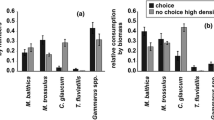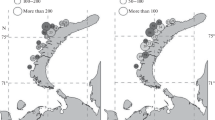Synopsis
Croilia mossambica, a burrowing goby endemic to the coastal lakes of south east Africa occurs from L. Poelela (salinity 8%.) to L. Sibaya (freshwater). Since these lakes are isolated from one another its distribution is discontinuous. It is not found in estuaries or the sea. In L. Sibaya C. mossambica is present on sheltered sides from a depth of 1 m to about 16 m. On exposed shores it is not found at less than 3.5 m depth. It is restricted to sandy, quiet water areas and is unable to form burrows where the substrate is disturbed by water movement, is muddy or consists of sand with a particle diameter greater than 0.5 mm. The maximum depth at which it lives is probably determined by light penetration since it is dependent on sight for prey capture. The food consists of slow moving benthic invertebrates such as chironomid larvae, gastropods, bivalves and amphipods. The relative importance of each depends upon its abundance. C. mossambica is a summer breeder with a protracted spawning season. The sticky eggs measure 0.7–0.8 mm when laid. Tolerance experiments show that it is euryhaline and can survive in seawater of 35%. and that its upper temperature limit is between 32 and 35°C. Temperatures in shallow waters of lakes and estuaries of the region frequently exceed 35°C. Thus its local distribution may be limited by temperature. Its lack of tolerance to high temperatures, to marked water movements and its ability to live in seawater indicates that C. mossambica is suited to life in the sea rather than in estuaries. It is suggested that it was present in quiet areas of the sea, such as lagoons, and that it invaded the coastal lakes which were formed as the estuaries and river valleys were inundated during the Pleistocene marine transgression. C. mossambica cannot tolerate estuarine conditions and with the present absence of quiet water in the sea off the south east African coast the species is now confined to deep coastal lakes.
Similar content being viewed by others
References cited
Allanson, B. R. & Hart, R. C. 1975. The primary production of Lake Sibaya, KwaZulu, South Africa. Verh. Internat. Verein. Limnol. 19: 1426–1433.
Allanson, B. R. & Van Wyk J. D. 1969. An introduction to the physics and chemistry of some lakes in Northern Zululand. Trans. R. Soc. S. Afr. 38: 217–240.
Allanson, B. R., Hill, B. J., Boltt, R. E. & Schultze, V. 1966. An estuarine fauna in a freshwater lake in South Africa. Nature, Lond. 209: 532–533.
Allanson, B. R., Bruton, M. N. & Hart, R. C. 1974. The plants and animals of Lake Sibaya, KwaZulu, South Africa: A checklist. Rev. Zool. Afr. 88: 507–532.
Blaber, S. J. M. 1973. Temperature and salinity tolerance of juvenile Rhabdosargus holubi (Steindachner) (Teleostei: Sparidae). J. Fish. Biol. 5: 593–598.
Blaber, S. J. M. 1974. Field studies of the diet of Rhabdosargus holubi (Pisces: Teleostei: Sparidae). J. Zool., Lond. 173: 407–417.
Blaber, S. J. M. 1976. The food and feeding ecology of Mugilidae in the St. Lucia Lake System. Biol. J. Linn. Soc. 8: 267–277.
Boltt, R. E. 1969. The benthos of some southern African lakes. Part II. The epifauna and infauna of the benthos of Lake Sibaya. Trans. R. Soc. S. Afr. 38: 249–269.
Boltt, R. E. 1975. The benthos of some southern African lakes. Part III. The benthic fauna of Lake Nhlange, KwaZulu, South Africa. Trans. R. Soc. S. Afr. 41: 241–262.
Hill, B. J. 1975. The origin of southern African coastal lakes. Trans. R. Soc. S. Afr. 41: 225–240.
Hill, B. J., Blaber, S. J. M. & Boltt, R. E. 1975. The limnology of Lagoa Poelela. Trans. R. Soc. S. Afr. 41: 263–271.
Orme, A. R. 1973. Barrier and lagoon systems along the Zululand coast, South Africa. pp. 181–217. In: D. R. Coates (ed.) Coastal Geormorphology, State University of New York, New York.
Smith, J. L. B. 1955. An interesting new gobiiform fish from South Africa. Ann. Mag. Nat. Hist. 12: 106–110.
Author information
Authors and Affiliations
Additional information
Note
Rights and permissions
About this article
Cite this article
Blaber, S.J.M., Whitfield, A.K. The biology of the burrowing goby Croilia mossambica Smith (Teleostei, Gobiidae). Environ Biol Fish 1, 197–204 (1977). https://doi.org/10.1007/BF00000411
Received:
Accepted:
Issue Date:
DOI: https://doi.org/10.1007/BF00000411




